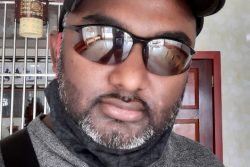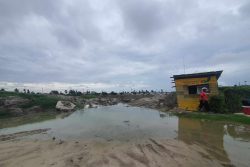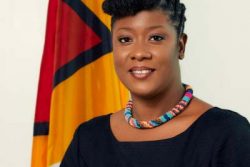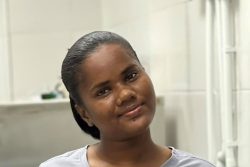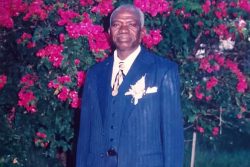On Friday the public in this country was made aware of some supreme eyepass on the part of Venezuela. It was reported that Jorge Rodríguez, President of that country’s National Assembly had gone to the National Electoral Council which manages Venezuela’s elections with two documents in his hand. One was a formal request for activating the referendum the Assembly had approved on September 21, whereby the Venezuelan people would be consulted on what was called the “dispute” over the territory of Essequibo; and the other was a draft of the possible questions which could be asked in that referendum. The Electoral Council would make the decision about those questions, he said, in the following 72 hours. While we might have to wait until Monday to learn what nonsense they have fabricated, in the meantime their President, Elvis Amoroso, announced that December 3 would be the date for the holding of this ludicrous exercise.
It would be no surprise for anyone to learn that President Nicolás Maduro wasted no time about having his say. During an event to commemorate the Day of the Communes, he was reported as urging the more than 49 thousand communal councils and 3,600 communes to debate the questions of the referendum. “[B]ut the greatest response,” he was quoted as saying, “has to be that of the Venezuelan people,” who should “go out en masse to vote for Guayana Esequiba [sic].”
The announcement of the date of December 3 has generated a considerable amount of wild, if not dangerous talk from government officials such as Vice President Delcy Rodríguez and more particularly Foreign Minister Yván Gil. “Guyana has turned its back on its people and has sided with the large transnationals and [is] at the service of the Pentagon,” said the first named. She went on to maintain that the announcement of the referendum date was “vital in defence of sovereignty and national integrity.”
As for Mr Gil, according to what he posted on his social media X account, he was exercised about
a pronouncement by Canada and Guyana on the sidelines of the Canada-Caricom summit, which has not been reported here, but which he alleged identified Venezuela as a priority for “security and stability”. He goes on to state that “the destabilizing position assumed by the Guyana government on behalf of the interests of ExxonMobil and the Southern Command is now joined by the hostility of the Canadian government … Qualifying Venezuela as a priority [in terms] of security and stability for both governments clearly denotes interventionist intentions that are unacceptable.”
Guyana, interventionist? He surely must mean Venezuela. But then this is the problem with such provocative language; it foments public anger and the authorities may find themselves faced with popular passions they cannot control, following which they are pushed into actions they didn’t intend. And then there is this senseless referendum. When the people vote in defence of their unjustifiable claim on Essequibo, which considering the brainwashing that has been going on for so many decades, they will, what then? What action will the government take? And if they do nothing, won’t they find themselves in a worse position than before they started, which may tempt them into ill-advised action?
The reason for all this is clear; it is related to the fact that Caracas wants relief from sanctions without too many concessions to the US on the political front. This is the classic distraction manoeuvre, as well as a way of telling America the entire nation is united behind Mr Maduro. In the meantime, as we reported last week, larger troop numbers on the other side of the Cuyuni have been recently in evidence. This is connected to a different development, although the danger is that soldiers deployed in response to one context, can always be used subsequently in a different one.
A few days ago the US Treasury’s Office of Foreign Assets Control issued four general licences suspending certain sanctions on Venezuela’s oil, gas and gold sectors. This followed an agreement on an electoral roadmap between the Maduro government and the unified opposition which was reached last week in Barbados. Elections in Venezuela are due next year. Of particular interest to Guyana is the licence authorizing dealings with Minerven, the Venezuelan state-owned gold-mining company. According to the US Treasury website the assessment was that this licence would serve to reduce the incidence of black-market trading in gold.
This might explain the appearance of the increased number of troops on the Venezuelan side of the Cuyuni River at this time, who might indeed be charged with dealing with illegal miners as Caracas has claimed. Since President Nicolás Maduro is in dire economic straits the Minerven licence would offer an avenue by which he could augment revenue, although since he has surrendered so much of the mining arc to illegal operators like the ELN near the Colombian frontier, and Sindicatos as well as a host of others along the border with Brazil and Guyana, he would first have to wrest back control from them. Whether he will be able to do that, even if he wants to, is very much an open question.
These licences are contingent on Venezuela upholding its side of the agreement, and Under Secretary of the Treasury for Terrorism and Financial Intelligence Brian E. Nelson was quoted on the website as saying: “Treasury is prepared to amend or revoke authorizations at any time, should representatives of Maduro fail to follow through on their commitments.” This is a reference to Miraflores’ political commitments, although whether if President Maduro failed to try and address the illegals in the mining arc, the gold licence would then come up for review, no one outside the US government knows.
If Caracas has really sent soldiers to confront illegal mining which is mostly, although not exclusively run by the Sindicatos opposite our stretch of the Cuyuni, that should be no cause for relaxation on our part. For one thing, if the Venezuelan military expels them, where are they going to go? They are armed and dangerous and some of them, at least, might decide to move in on our bank. It may be too that Miraflores would be happy to have them do that to secure a blurring along the border.
Considering what has been going on in that area for a long time, it does not seem that there are enough Guyanese military personnel stationed there to cope with a situation like that. The problem would be compounded if, as was suggested last week, troops crossed the river and intruded on our land with the excuse they were chasing gang members. It is not as if we can swiftly reinforce security personnel there since the Eteringbang airstrip has been out of commission for some time.
Its rehabilitation was supposed to have been completed in July, but the last statement on the subject from Public Works Minister Juan Edghill was that it would now be finished by the end of the year. He gave no reason for the delay, but what it would mean in an emergency is that reinforcements would have to come by river, which would represent the precise opposite of an emergency response. Perhaps the government should be looking at sending in additional personnel now as a security measure, not to mention insisting on speeding up the Eteringbang strip repairs.
The urgency for looking at the security of the Cuyuni/Wenamu area is also affected by the setting of a date for the Venezuelan consultative referendum. As already noted, the consequences of that are not easily predicted, but also as said earlier, since Caracas already has military in the region in some numbers, probably as indicated to expel illegal miners, this can be a cover for all kinds of activities inimical to this country. The government in association with the opposition and the military needs to put its mind to ‘what if …’ scenarios.
The constant recitations by Venezuelan officials about ‘defending our’ Essequibo are extraordinarily tiresome, but perhaps the most irritating one runs, ‘Venezuela’s sun rises in Essequibo.’ It doesn’t. It rises on the west bank of the Cuyuni along a line established in 1899 to Punta Playa.
